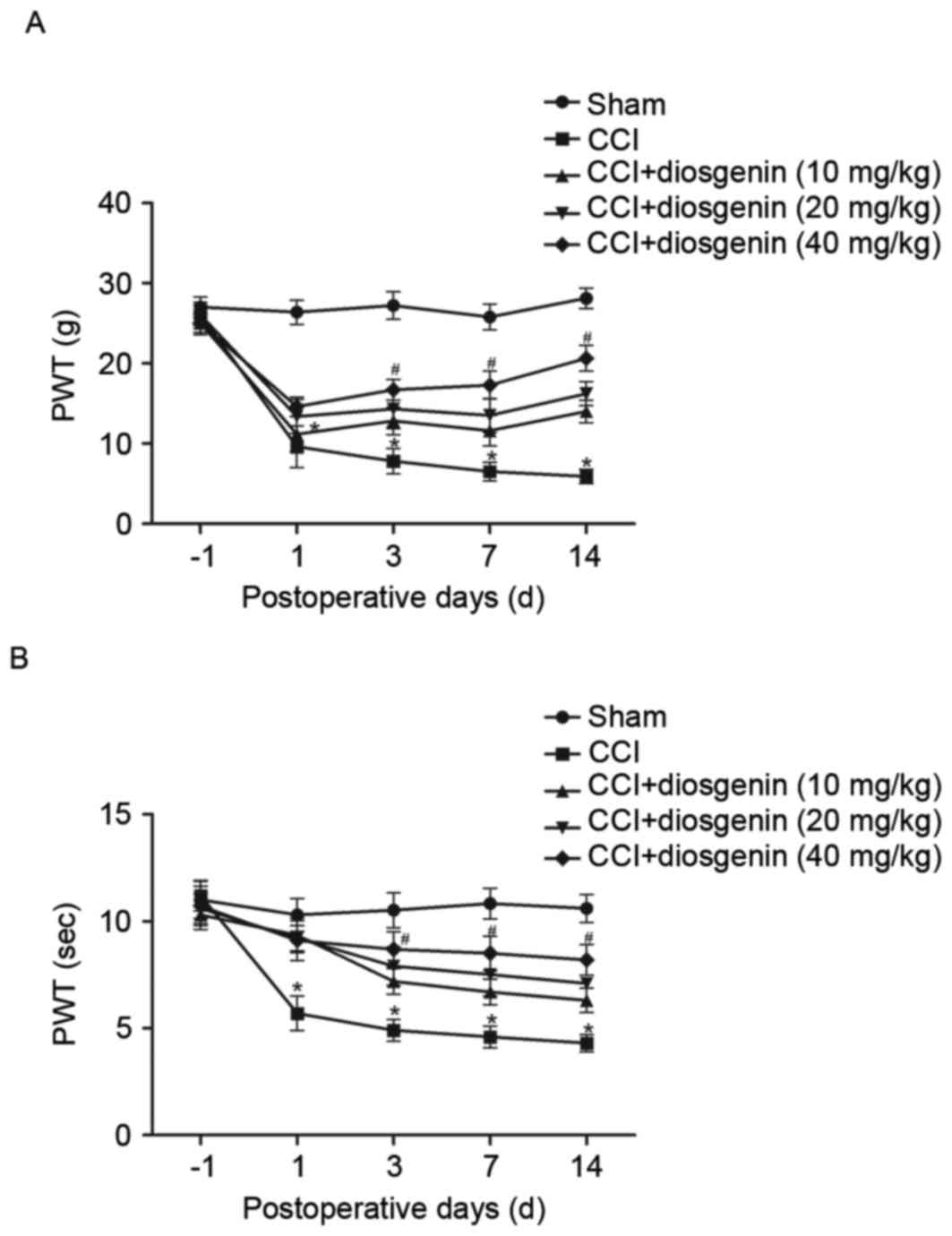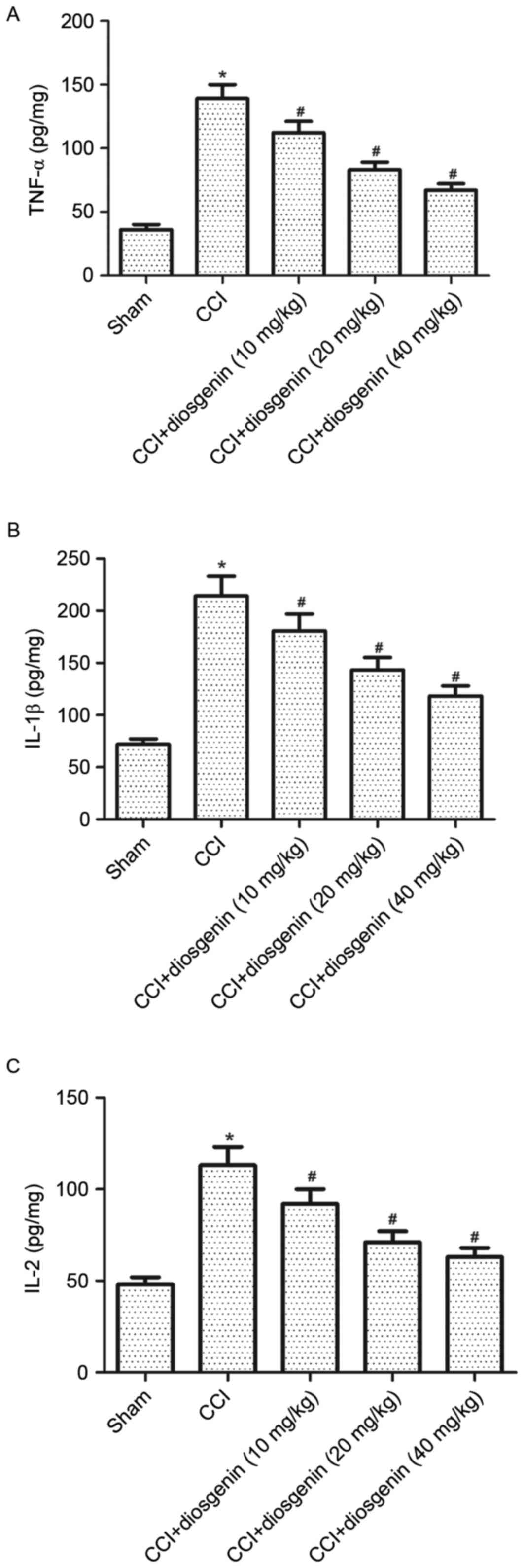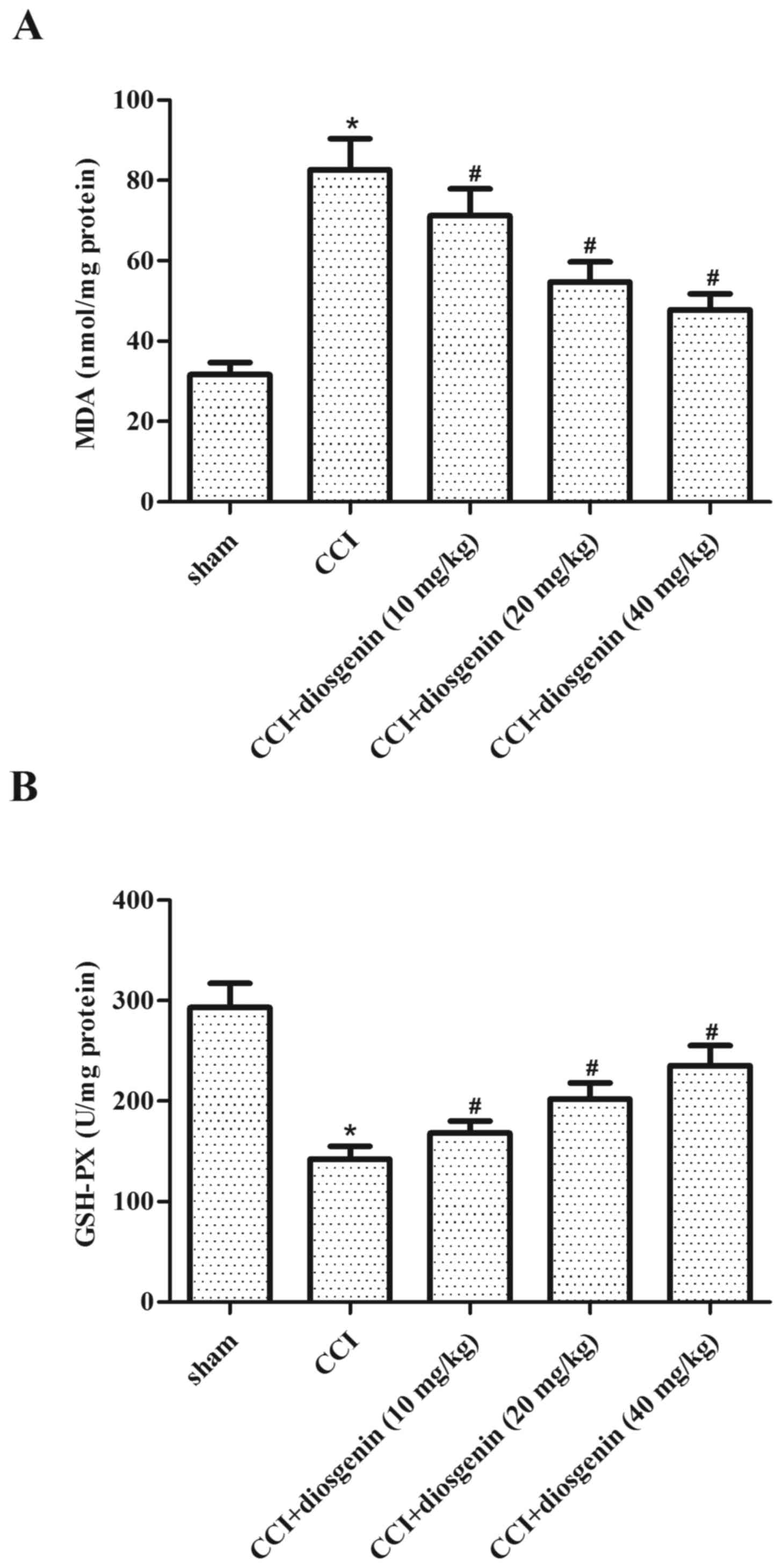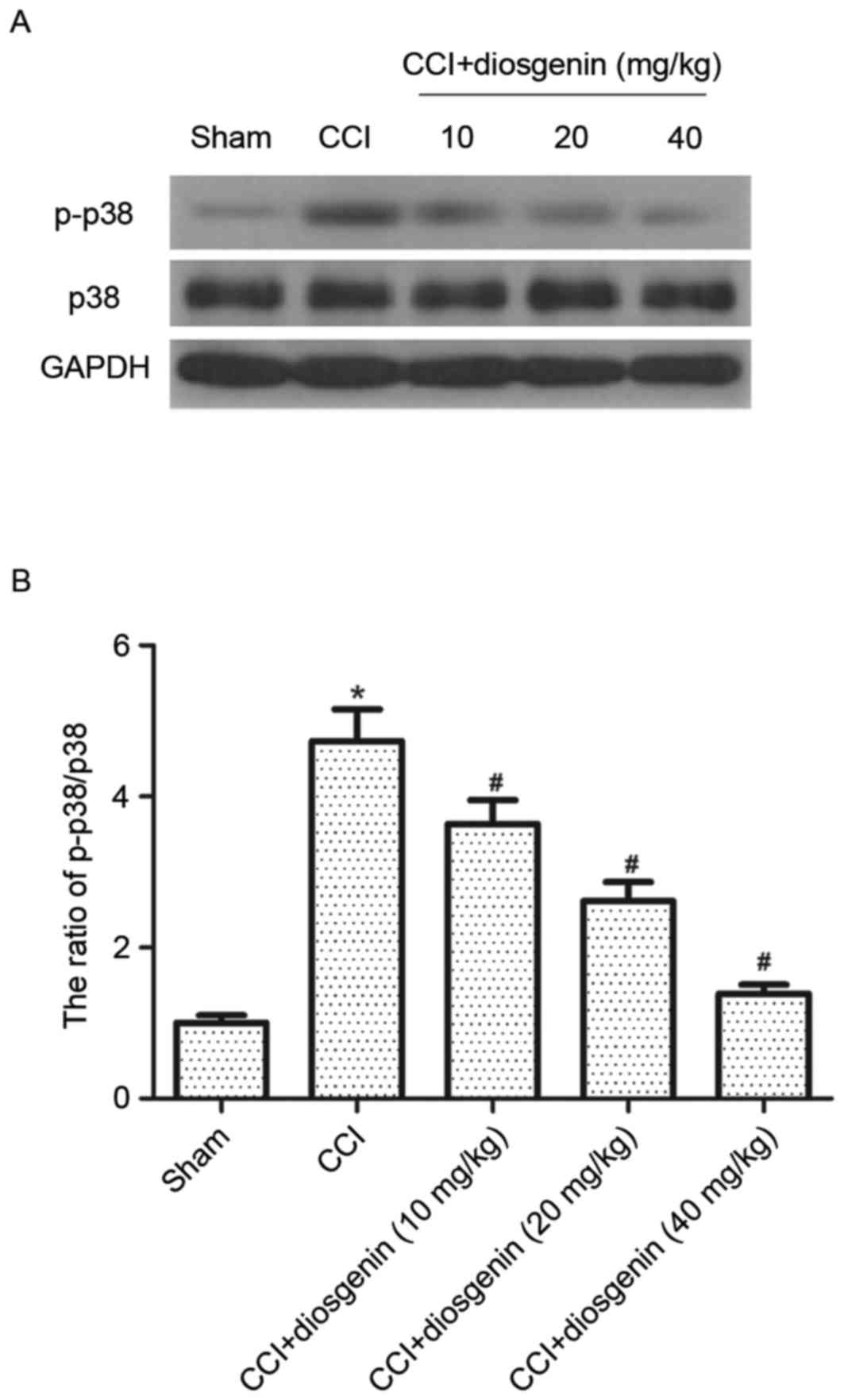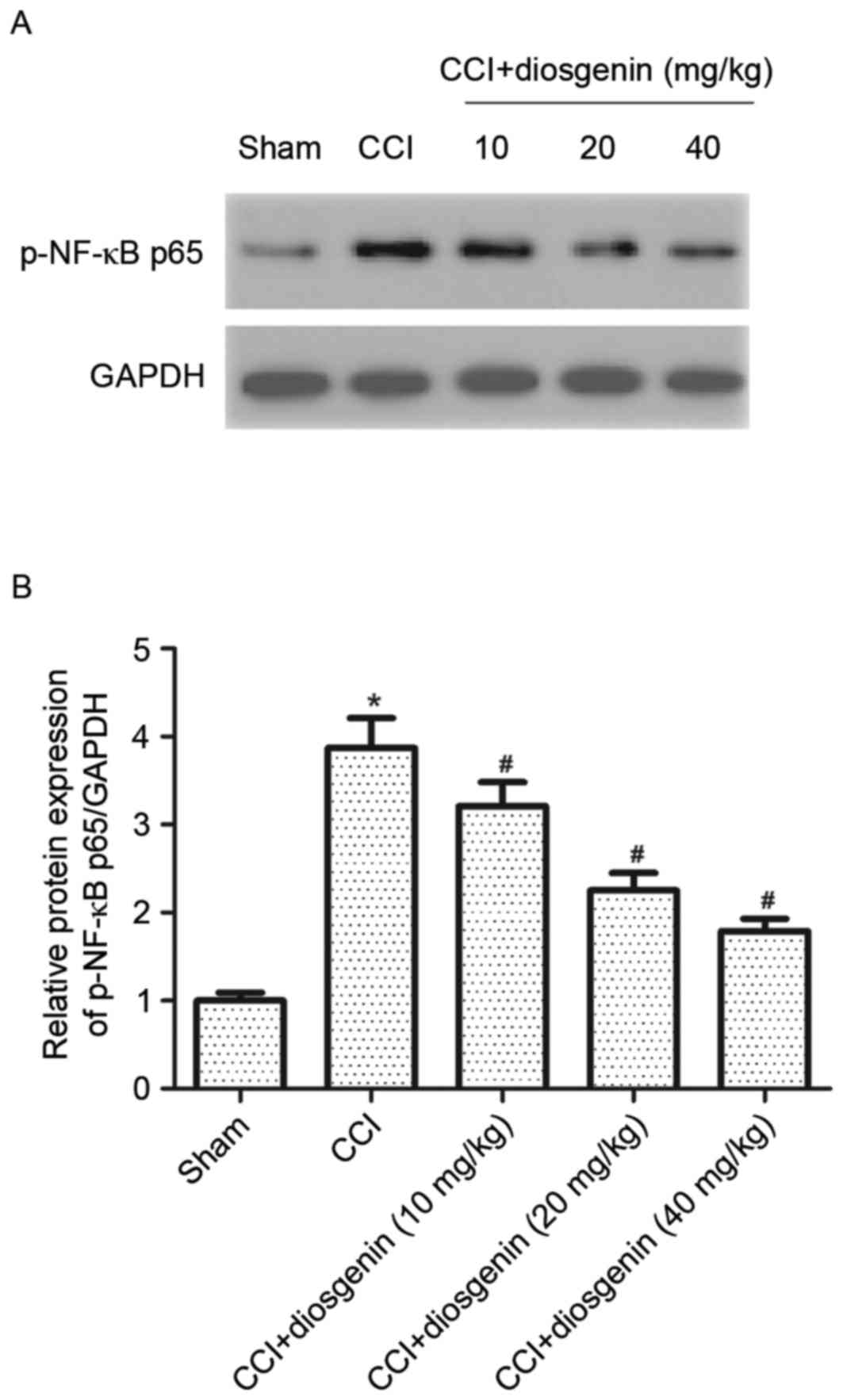Diosgenin attenuates neuropathic pain in a rat model of chronic constriction injury
- Authors:
- Published online on: June 8, 2017 https://doi.org/10.3892/mmr.2017.6723
- Pages: 1559-1564
Abstract
Introduction
Neuropathic pain is a major chronic condition arising from injury or disease affecting the peripheral or central nervous system (1). It is characterized by hyperalgesia, allodynia and spontaneous pain. Nowadays, neuropathic pain has become a significant public health problem, affecting ~10–40% of the general population (2). Despite immense advances in treatment strategies, the effective treatment of patients suffering from neuropathic pain remains challenging (3,4). Thus, it is urgent to investigate effective and nontoxic analgesics for the management of neuropathic pain.
Accumulating evidence has demonstrated that nerve injury-induced inflammatory cytokines and reactive oxygen species (ROS) serve important roles in the progress of neuropathic pain (5–7). Nerve damage causes the upregulation of inflammatory mediators, including tumor necrosis factor (TNF)-α and interleukin (IL)-1β (8,9). Nuclear factor (NF)-κB, a critical regulator of inflammatory process, has also been demonstrated to be activated in neuropathic pain (10). Therefore, inhibition of these cytokines attenuates nerve injury-induced allodynia.
Diosgenin is a steroidal saponin extract from numerous plants, including Solanum and Dioscorea species. Increasing evidences have reported that diosgenin has multiple pharmacological activities, including anti-inflammatory, anti-oxidant and anti-cancer properties (11–13). In addition, diosgenin has been reported to exert neuroprotective activity. For example, diosgenin significantly improved memory function and reduced axonal degeneration in an Alzheimer's disease mouse model (14). However, the role of diosgenin in neuropathic pain remains unclear. The present study examined the effects of diosgenin on allodynia, and the levels of inflammatory mediators in rats following neuropathic pain evoked by chronic constriction injury (CCI). In addition, the underlying molecular mechanisms involved in the diosgenin-induced suppression of neuropathic pain were investigated.
Materials and methods
Animals
Male Sprague-Dawley rats (n=25) weighing 180–200 g were supplied by the Experimental Animal Centre of Zhengzhou Central Hospital Affiliated to Zhengzhou University (Zhengzhou, China). The animals were housed in a room maintained at 22±1°C with an alternating 12-h light/dark cycle, and provided food and water ad libitum. The animal experimental procedures were approved and reviewed by the Institutional Animal Care and Use Committee of Zhengzhou Central Hospital Affiliated to Zhengzhou University.
Induction of neuropathic pain
Neuropathic pain was induced in experimental animals by CCI of the sciatic nerve which was performed as previously described (15). In brief, rats were anesthetized intraperitoneally with 40 mg/kg sodium pentobarbital (Sigma-Aldrich; Merck KGaA, Darmstadt, Germany). Four ligatures (silk 4–0) were tied loosely around proximal bifurcation part of the nerve with 1 mm spacing between each ligature, until a brisk twitch of the right hind limb was observed. Sham surgery was performed with the sciatic nerve exposed but not ligated in control rats (n=3 per group).
Drug treatment
Diosgenin in doses of 10, 20 and 40 mg/kg were administered intraperitoneally to neuropathic rats once a day for two weeks, starting from the first day following the induction of neuropathic pain; the sham-operated rats received normal saline (20 µl) alone, following the same treatment procedure. The rats were sacrificed by spinal dislocation 24 h after the last administration.
Evaluation of mechanical allodynia and thermal hyperalgesia
Mechanical allodynia was evaluated as indicated by the paw withdrawal threshold in response to von Frey filaments using the up-down method according to previously described protocol (16). In brief, rats were placed in an inverted clear plexiglass cage (23×18×13 cm) on a 3-mm-thick glass plate, and were allowed to acclimatize for 30 min before testing. The plantar surface of each hind paw was applied with pressure from below with the electronic Von Frey filament via the mesh floor. The force applied at the time of paw withdrawal was recorded.
Heat hypersensitivity was tested using a plantar test (cat. no. 7370; Ugo Basile Srl, Varese, Italy) according to a method described previously (17). In brief, the heat source was positioned under the glass floor directly beneath the hind paw. The heat intensity was set to last for ~10 sec to produce paw withdrawal latency, and the cut-off was set at 20 sec to avoid tissue damage. Each paw was measured alternatively after >5 min.
Western blot analysis
At day 14, the rats were sacrificed by spinal dislocation. Then, the lumbar spinal cord tissues (L4/5) were rapidly removed. Proteins were extracted from the lumbar spinal cord tissues (L4/5) using RIPA Cell Lysis Buffer (Takara Biotechnology, Dalian, China). Lysates were sonicated for 5 sec on ice and centrifuged at 6,000 × g for 10 min at 4°C. Supernatants were collected and the protein concentration was quantified using a Pierce Bicinchoninic Acid Protein Assay kit (Pierce; Thermo Fisher Scientific, Inc., Waltham, MA, USA). Equal amounts of protein (30 µg) were separated by 10% SDS-PAGE and subsequently transferred to polyvinylidene difluoride membranes. The membrane was blocked with 5% non-fat dry milk in Tris-buffered saline with 0.1% Tween-20 (TBST) for 1 h at room temperature. The membrane was then incubated with a 1:1,000 dilution of the following primary antibodies, all purchased from Santa Cruz Biotechnology Inc. (Dallas, TX, USA): rabbit anti-mouse phosphorylated (p)-p38 mitogen activated protein kinase (MAPK) antibody (sc-101759; 1:3,000), rabbit anti-mouse p38 MAPK antibody (sc-535; 1:2,500), rabbit anti-mouse p-NF-κB p65 antibody (sc-33020; 1:3,000;) and rabbit anti-mouse GAPDH antibody (sc-25778; 1:2,500) overnight at 4°C. Following three washes with TBST buffer, the membrane was washed and incubated with a goat anti-rabbit IgG horseradish peroxidase-conjugated secondary antibody (sc-2030; 1:2,500) for 1 h at 37°C. Proteins were subsequently detected by Enhanced Chemiluminescence (GE Healthcare Life Sciences, Chalfont, UK) and quantified using Gel-Pro Analyzer version 4.0 software (Media Cybernetics, Inc., Rockville, MD, USA).
Enzyme linked immunosorbent assay (ELISA)
The levels of TNF-α, IL-1β and IL-2 in the lumbar spinal cords were measured using commercially available rat TNF-α (RAB0479), IL-1β (RAB0277) and IL-2 (RAB0288) ELISA kits (Sigma-Aldrich; Merck KGaA) according to the manufacturer's protocol. Plates were read using an ELISA reader (Omega Bio-Tek, Inc., Norcross, GA, USA) at a wavelength of 450 nm.
The levels of malondialdehyde (MDA) and glutathione peroxidase (GSH-PX) in the lumbar spinal cords were estimated by using MDA and GSH-PX kits from the Biological Engineering Research Institute (Nanjing, China).
Statistical analysis
Analysis was performed using SPSS 16.0 software (SPSS, Inc., Chicago, IL, USA). All data are presented as the mean ± standard deviation. The data of behavioral tests were analyzed by two-way analysis of variance, while the data of cytokine assays were analyzed by one-way analysis of variance, followed by Newman-Keuls post hoc test. P<0.05 were considered to indicate a statistically significant difference.
Results
Effect of diosgenin on mechanical allodynia and thermal hyperalgesia
The effects of diosgenin on mechanical allodynia and thermal hyperalgesia were examined. CCI resulted in significant development of mechanical allodynia (Fig. 1A) and thermal hyperalgesia (Fig. 1B), as compared with the sham group as assessed on day 1, 7 and 14. However, diosgenin treatment reversed CCI-induced mechanical allodynia and thermal hyperalgesia in a dose-dependent manner.
Effect of diosgenin on pro-inflammatory cytokine levels in the spinal cord
There is strong evidence that pro-inflammatory cytokines have important roles in the pathology of neuropathic pain. Thus, the present study examined the effects of diosgenin on pro-inflammatory cytokine levels in spinal cord by ELISA. The levels of TNF-α (Fig. 2A), IL-1β (Fig. 2B) and IL-2 (Fig. 2C) were significantly increased in the spinal cord of CCI rats compared with the sham group. However, diosgenin reversed CCI-increased levels of TNF-α, IL-1β and IL-2 in a dose-dependent manner.
Effect of diosgenin on oxidative stress in the spinal cord, following CCI
The effects of diosgenin on oxidative stress in spinal cord were examined by ELISA. Rats in the CCI group exhibited a significant increase in the production of MDA (Fig. 3A) and decrease in the content of GSH-PX (Fig. 3B), compared with the sham group. Diosgenin treatment obviously reversed CCI-induced oxidative stress in spinal cord in a dose-dependent manner.
Effect of diosgenin on p-p38 MAPK in the spinal cord, following CCI
It has been reported that activation of p-p38 MAPK contributes to the development of inflammatory and neuropathic pain induced by nerve injury. Therefore, the effects of diosgenin on phosphorylation of p38 MAPK in spinal cord were investigated. As presented in Fig. 4, protein expression levels of p-p38 MAPK were greatly increased by CCI, compared with the sham group. However, diosgenin treatment significantly inhibited the expression level of p-p38 MAPK in the spinal cord of CCI rats.
Effect of diosgenin on NF-κB activation in the spinal cord, following CCI
The NF-κB signaling pathway serves a key role in regulating the expression of pro-inflammatory and pain mediators. To investigate the underlying mechanism of diosgenin in CCI-induced neuropathic pain, protein expression levels of p-NF-κB p65 in spinal cord of CCI rats were detected. Western blot analysis demonstrated that the CCI group had significantly increased levels of p-NF-κB p65, compared with the sham group. However, diosgenin markedly decreased the expression of p-NF-κB p65 in the spinal cord of CCI rats, in a dose-dependent manner (Fig. 5).
Discussion
The present study demonstrated that diosgenin reversed CCI-decreased mechanical withdrawal threshold and thermal withdrawal latency. Diosgenin inhibited CCI-induced increased levels of the pro-inflammatory cytokines TNF-α, IL-1β and IL-2, and suppressed oxidative stress induced by CCI in the spinal cord. Furthermore, diosgenin significantly inhibited protein expression levels of p-p38 MAPK and NF-κB in the spinal cord induced by CCI.
The CCI model is the most commonly employed neuropathic pain model of nerve damage-induced allodynia/hyperalgesia (18). The present study constructed the CCI model to investigate the effects of diosgenin on allodynia/hyperalgesia and the levels of inflammatory mediators in rats following neuropathic pain. It was observed that CCI led to significant development of mechanical allodynia and heat hyperalgesia following surgery. However, diosgenin reversed CCI-induced mechanical allodynia and thermal hyperalgesia in a dose-dependent manner. These data suggested that diosgenin may attenuate neuropathic pain in a CCI model.
Increasing evidence suggests that peripheral nerve injury contributes to neuropathic pain via upregulation of pro-inflammatory cytokines (19–21). TNF-α is a predominant pro-inflammatory cytokine contributing to pain hypersensitivity following nerve damage; intrathecal injection of a TNF-α inhibitor prior to nerve injury reduces neuropathology and pain-associated behaviors (22). In addition, IL-1β levels increase significantly in the sciatic nerve following CCI (23). Consistent with previous studies, the present study demonstrated that the levels of TNF-α, IL-1β and IL-2 were significantly increased in the spinal cord of CCI rats, compared sham-operated rats. However, diosgenin treatment reversed this effect in a dose-dependent manner. These results suggested that the beneficial effects of diosgenin in CCI-induced neuropathic pain are mediated via its attenuating effect on pro-inflammatory mediators.
Previous studies have indicated that CCI produces significant oxidative damage in the sciatic nerve due to the increase in lipid peroxidation and ROS concentration (7,24). Administration of natural and synthetic ROS scavengers reduces allodynia and hyperalgesia in a number of neuropathic pain models (25,26). The present study revealed that CCI resulted in a significant increase in the production of MDA, and a decrease in the content of GSH-PX. However, diosgenin treatment reversed the CCI-induced oxidative stress in the spinal cord. These results suggested that the beneficial effects of diosgenin in CCI-induced neuropathic pain are mediated via its attenuating effect on oxidative stress.
Previous studies have demonstrated that p-p38 MAPK in spinal cord glial cells after peripheral nerve injury are involved in the development of neuropathic pain (27–29). Tsuda et al (30) reported that administration of a p38 MAPK inhibitor attenuates the development of nerve injury-induced tactile allodynia. Furthermore, the NF-κB signaling pathway has been implicated in the mediation of neuropathic pain (31–33). Intrathecal infusion of the NF-κB inhibitor ammonium pyrrolidine dithiocarbamate improved mechanical allodynia and downregulated the overexpression of TNF-α induced by peri-sciatic administration of TNF (34). The present study revealed that diosgenin significantly inhibited CCI-induced upregulated expression levels of p-p38 MAPK and p-NF-κB p65 in the spinal cord. These data suggested that diosgenin attenuates neuropathic pain in CCI rats by inhibiting activation of the p38 MAPK and NF-κB signaling pathways.
In conclusion, the present study demonstrated that diosgenin may be effective to reduce neuropathic pain by inhibition of activation of the p38 MAPK and NF-κB signaling pathways. These results implicate diosgenin in the treatment of neuropathic pain, which merits further clinical investigation.
References
|
Rowbotham MC: Mechanisms of neuropathic pain and their implications for the design of clinical trials. Neurology. 65 12 Suppl 4:S66–S73. 2005. View Article : Google Scholar : PubMed/NCBI | |
|
Neville A, Peleg R, Singer Y, Sherf M and Shvartzman P: Chronic pain: A population-based study. Isr Med Assoc J. 10:676–680. 2008.PubMed/NCBI | |
|
Baastrup C and Finnerup NB: Pharmacological management of neuropathic pain following spinal cord injury. CNS Drugs. 22:455–475. 2008. View Article : Google Scholar : PubMed/NCBI | |
|
Finnerup NB, Otto M, McQuay H, Jensen TS and Sindrup SH: Algorithm for neuropathic pain treatment: An evidence based proposal. Pain. 118:289–305. 2005. View Article : Google Scholar : PubMed/NCBI | |
|
Dray A: Inflammatory mediators of pain. Brit J Anaesth. 75:125–131. 1995. View Article : Google Scholar : PubMed/NCBI | |
|
DeLeo JA and Yezierski RP: The role of neuroinflammation and neuroimmune activation in persistent pain. Pain. 90:1–6. 2001. View Article : Google Scholar : PubMed/NCBI | |
|
Kim HK, Park SK, Zhou JL, Taglialatela G, Chung K, Coggeshall RE and Chung JM: Reactive oxygen species (ROS) play an important role in a rat model of neuropathic pain. Pain. 111:116–124. 2004. View Article : Google Scholar : PubMed/NCBI | |
|
Ohtori S, Takahashi K, Moriya H and Myers RR: TNF-alpha and TNF-alpha receptor type 1 upregulation in glia and neurons after peripheral nerve injury: Studies in murine DRG and spinal cord. Spine (Phila Pa 1976). 29:1082–1088. 2004. View Article : Google Scholar : PubMed/NCBI | |
|
Taves S, Berta T, Chen G and Ji RR: Microglia and spinal cord synaptic plasticity in persistent pain. Neural Plast. 2013:7536562013. View Article : Google Scholar : PubMed/NCBI | |
|
Ma W and Bisby MA: Increased activation of nuclear factor kappa B in rat lumbar dorsal root ganglion neurons following partial sciatic nerve injuries. Brain Res. 797:243–254. 1998. View Article : Google Scholar : PubMed/NCBI | |
|
Jung DH, Park HJ, Byun HE, Park YM, Kim TW, Kim BO, Um SH and Pyo S: Diosgenin inhibits macrophage-derived inflammatory mediators through downregulation of CK2, JNK, NF-kappaB and AP-1 activation. Int Immunopharmacol. 10:1047–1054. 2010. View Article : Google Scholar : PubMed/NCBI | |
|
Son IS, Kim JH, Sohn HY, Son KH, Kim JS and Kwon CS: Antioxidative and hypolipidemic effects of diosgenin, a steroidal saponin of yam (Dioscorea spp.), on high-cholesterol fed rats. Biosci Biotechnol Biochem. 71:3063–3071. 2007. View Article : Google Scholar : PubMed/NCBI | |
|
Moalic S, Liagre B, Corbière C, Bianchi A, Dauça M, Bordji K and Beneytout JL: A plant steroid, diosgenin, induces apoptosis, cell cycle arrest and COX activity in osteosarcoma cells. FEBS Lett. 506:225–230. 2001. View Article : Google Scholar : PubMed/NCBI | |
|
Tohda C, Urano T, Umezaki M, Nemere I and Kuboyama T: Diosgenin is an exogenous activator of 1, 25D3-MARRS/Pdia3/ERp57 and improves Alzheimer's disease pathologies in 5XFAD mice. Sci Rep. 2:5352012. View Article : Google Scholar : PubMed/NCBI | |
|
Bennett GJ and Xie YK: A peripheral mononeuropathy in rat that produces disorders of pain sensation like those seen in man. Pain. 33:87–107. 1988. View Article : Google Scholar : PubMed/NCBI | |
|
Chaplan SR, Bach FW, Pogrel JM, Chung JM and Yaksh TL: Quantitative assessment of tactile allodynia in the rat paw. J Neurosci Methods. 53:55–63. 1994. View Article : Google Scholar : PubMed/NCBI | |
|
Hargreaves K, Dubner R, Brown F, Flores C and Joris J: A new and sensitive method for measuring thermal nociception in cutaneous hyperalgesia. Pain. 32:77–88. 1988. View Article : Google Scholar : PubMed/NCBI | |
|
Jaggi AS, Jain V and Singh N: Animal models of neuropathic pain. Fund Clin Pharmacol. 25:1–28. 2011. View Article : Google Scholar | |
|
Nadeau S, Filali M, Zhang J, Kerr BJ, Rivest S, Soulet D, Iwakura Y, de Rivero Vaccari JP, Keane RW and Lacroix S: Functional recovery after peripheral nerve injury is dependent on the pro-inflammatory cytokines IL-1β and TNF: Implications for neuropathic pain. J Neurosci. 31:12533–12542. 2011. View Article : Google Scholar : PubMed/NCBI | |
|
Detloff MR, Fisher LC, McGaughy V, Longbrake EE, Popovich PG and Basso DM: Remote activation of microglia and pro-inflammatory cytokines predict the onset and severity of below-level neuropathic pain after spinal cord injury in rats. Exp Neurol. 212:337–347. 2008. View Article : Google Scholar : PubMed/NCBI | |
|
Zhang JM and An J: Cytokines, inflammation, and pain. Int Anesthesiol Clin. 45:27–37. 2007. View Article : Google Scholar : PubMed/NCBI | |
|
Zanella JM, Burright EN, Hildebrand K, Hobot C, Cox M, Christoferson L and McKay WF: Effect of etanercept, a tumor necrosis factor-alpha inhibitor, on neuropathic pain in the rat chronic constriction injury model. Spine (Phila Pa 1976). 33:227–234. 2008. View Article : Google Scholar : PubMed/NCBI | |
|
del Rey A, Yau HJ, Randolf A, Centeno MV, Wildmann J, Martina M, Besedovsky HO and Apkarian AV: Chronic neuropathic pain-like behavior correlates with IL-1β expression and disrupts cytokine interactions in the hippocampus. Pain. 152:2827–2835. 2011. View Article : Google Scholar : PubMed/NCBI | |
|
Park ES, Gao X, Chung JM and Chung K: Levels of mitochondrial reactive oxygen species increase in rat neuropathic spinal dorsal horn neurons. Neurosci Lett. 391:108–111. 2006. View Article : Google Scholar : PubMed/NCBI | |
|
Navarro SA, Serafim KG, Mizokami SS, Hohmann MS, Casagrande R and Verri WA Jr: Analgesic activity of piracetam: Effect on cytokine production and oxidative stress. Pharmacol Biochem Behav. 105:183–192. 2013. View Article : Google Scholar : PubMed/NCBI | |
|
Twining CM, Sloane EM, Milligan ED, Chacur M, Martin D, Poole S, Marsh H, Maier SF and Watkins LR: Peri-sciatic proinflammatory cytokines, reactive oxygen species and complement induce mirror-image neuropathic pain in rats. Pain. 110:299–309. 2004. View Article : Google Scholar : PubMed/NCBI | |
|
Ji RR and Suter MR: p38 MAPK, microglial signaling, and neuropathic pain. Mol Pain. 3:332007. View Article : Google Scholar : PubMed/NCBI | |
|
Zhuang ZY, Kawasaki Y, Tan PH, Wen YR, Huang J and Ji RR: Role of the CX3CR1/p38 MAPK pathway in spinal microglia for the development of neuropathic pain following nerve injury-induced cleavage of fractalkine. Brain Behav Immun. 21:642–651. 2007. View Article : Google Scholar : PubMed/NCBI | |
|
Hua XY, Svensson CI, Matsui T, Fitzsimmons B, Yaksh TL and Webb M: Intrathecal minocycline attenuates peripheral inflammation-induced hyperalgesia by inhibiting p38 MAPK in spinal microglia. Eur J Neurosci. 22:2431–2440. 2005. View Article : Google Scholar : PubMed/NCBI | |
|
Tsuda M, Mizokoshi A, Shigemoto-Mogami Y, Koizumi S and Inoue K: Activation of p38 mitogen-activated protein kinase in spinal hyperactive microglia contributes to pain hypersensitivity following peripheral nerve injury. Glia. 45:89–95. 2004. View Article : Google Scholar : PubMed/NCBI | |
|
Sun T, Song WG, Fu ZJ, Liu ZH, Liu YM and Yao SL: Alleviation of neuropathic pain by intrathecal injection of antisense oligonucleotides to p65 subunit of NF-kappaB. Brit J Anaesth. 97:553–558. 2006. View Article : Google Scholar : PubMed/NCBI | |
|
Tegeder I, Niederberger E, Schmidt R, Kunz S, Gühring H, Ritzeler O, Michaelis M and Geisslinger G: Specific inhibition of IkappaB kinase reduces hyperalgesia in inflammatory and neuropathic pain models in rats. J Neurosci. 24:1637–1645. 2004. View Article : Google Scholar : PubMed/NCBI | |
|
Lee KM, Jeon SM and Cho HJ: Tumor necrosis factor receptor 1 induces interleukin-6 upregulation through NF-kappaB in a rat neuropathic pain model. Eur J Pain. 13:794–806. 2009. View Article : Google Scholar : PubMed/NCBI | |
|
Wei XH, Yang T, Wu Q, Xin WJ, Wu JL, Wang YQ, Zang Y, Wang J, Li YY and Liu XG: Peri-sciatic administration of recombinant rat IL-1β induces mechanical allodynia by activation of src-family kinases in spinal microglia in rats. Exp Neurol. 234:389–397. 2012. View Article : Google Scholar : PubMed/NCBI |



